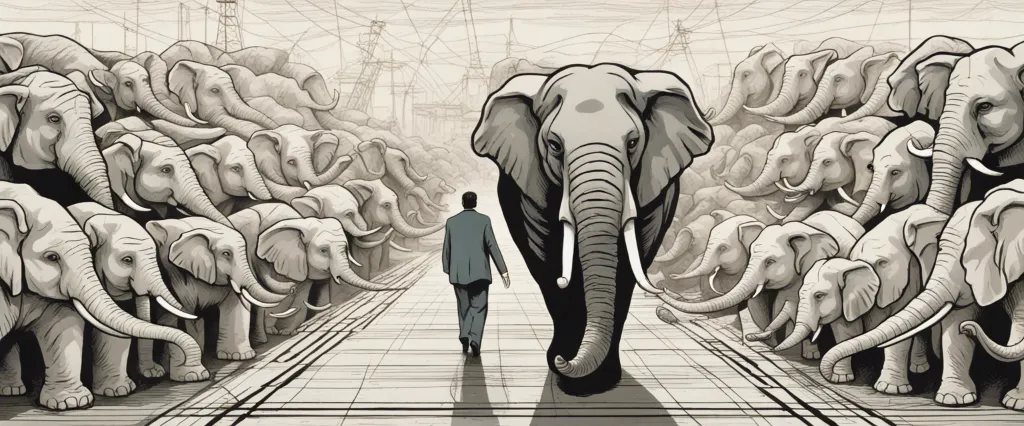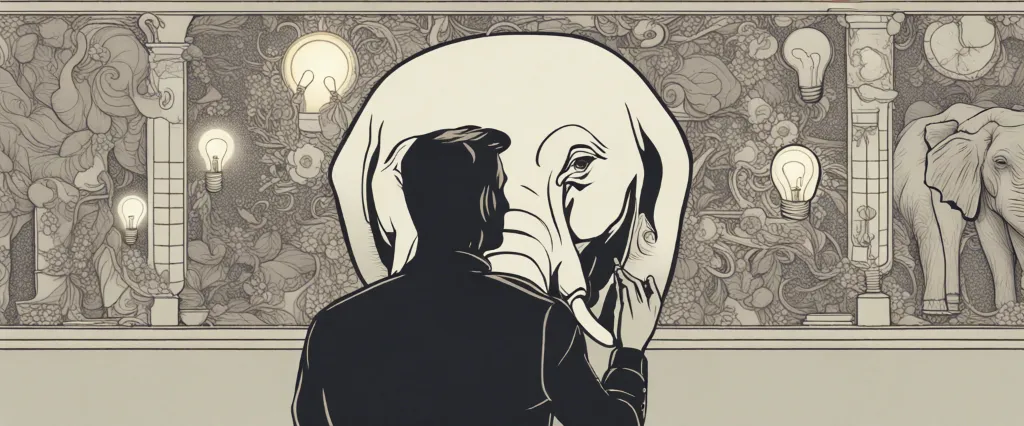In “The Elephant in the Brain“, Kevin Simler explores the hidden motives behind our thoughts and actions, revealing that humans are not as morally virtuous as we often believe ourselves to be. Stemming from his background in computer science, Simler delves into the concept of hidden agendas, explaining how our brains are wired to prioritize self-interest over benevolence. Through a thought-provoking analysis of various aspects of human behavior, the author sheds light on our inherent drive for social status and how it influences our interactions, institutions, and even our most cherished values.
Chapter 1: The Hidden Psychological Drivers
Chapter 1 of “The Elephant in the Brain” by Kevin Simler explores the concept of hidden motives that drive human behavior, particularly in social settings. The chapter begins by introducing the metaphor of the “elephant in the brain,” referring to our hidden motivations that are often unknown even to ourselves. The author argues that while we like to believe we act in noble and altruistic ways, there are often underlying and more self-serving motives behind our actions.
Simler explains that our brains are wired to prioritize our self-interests, and this self-interest often remains hidden because it is socially unacceptable or frowned upon. The chapter provides various examples of hidden motives, such as attending a prestigious university not solely for the education but for the signaling value it provides, or engaging in conspicuous acts of charity to increase social status. These behaviors, although seemingly benevolent on the surface, actually serve as means to further personal gain.
The chapter also focuses on the theory of signaling, which suggests that a significant portion of human behavior is driven by the need to display desirable qualities and characteristics to others. It argues that much of our behavior is oriented around demonstrating our competence, reliability, and trustworthiness to gain social acceptance and enhance our chances of success.
In summary, Chapter 1 explores the hidden psychological drivers that influence our behavior. It highlights how our brains are wired to prioritize self-interest, often leading us to engage in actions that serve as subtle signals and increase our social standing, even when we may not consciously realize it. The chapter provides examples of how these hidden motives manifest in various aspects of life and sets the stage for further exploration of this intriguing phenomenon in the book.
Chapter 2: Self-Deception and Self-Preservation
Chapter 2 of “The Elephant in the Brain” by Kevin Simler explores the concept of self-deception and its connection to self-preservation. It delves into how our brains tend to deceive us, often without our conscious knowledge, in order to protect our own interests and maintain social harmony.
The chapter begins by highlighting the prevalence of self-deception in everyday life, explaining that it occurs not only to deceive others but also to deceive ourselves. It suggests that self-deception serves as a coping mechanism, allowing us to navigate complex social situations and maintain our self-image intact.
The chapter then explores various examples of self-deception, such as the hidden motives behind acts of charity or the tendency to mask our true intentions when providing compliments. It argues that these actions, while seemingly altruistic, often have self-serving components that we are not consciously aware of.
Simler introduces the concept of “self-signaling” as a mechanism that enables self-deception. Self-signaling refers to the way our actions and behaviors project certain qualities or values about ourselves. By engaging in behaviors that signal specific traits, we deceive ourselves into believing that we possess those qualities more than we actually do.
The chapter concludes by highlighting the evolutionary advantages of self-deception. It suggests that by deceiving ourselves, we are better able to convince others of our sincerity and maintain social cohesion. However, Simler also suggests that recognizing and understanding our own self-deception is essential for personal growth and enhanced self-awareness.
Overall, Chapter 2 of “The Elephant in the Brain” provides insight into the deceptive nature of our minds and the ways in which we protect our own self-interests through self-deception. It encourages readers to reflect on their own motivations and actions, as well as explore the deeper layers of their unconscious minds.
Chapter 3: Social Signals and Social Games
Chapter 3 of “The Elephant in the Brain” by Kevin Simler explores the concept of social signals and social games, unveiling hidden motives and unconscious behaviors in social interactions. The chapter delves into the idea that much of our behavior is driven by a desire to gain social status and influence, even if we are not consciously aware of it.
Starting with the concept of signaling, the author explains that human beings use various subtle and not-so-subtle signals to convey information about themselves. These signals can be both conscious and unconscious, and they play a crucial role in shaping our social interactions. For example, people often engage in conspicuous consumption, such as buying luxury goods, to signal their wealth and status to others.
Simler then explores the idea of social games, which are essentially strategic interactions where individuals compete for social status. These games are prevalent in various domains, including academics, politics, and business. One important game is the “status game,” where people vie for respect, admiration, and influence. These games often involve conflicting goals, as individuals strive to enhance their personal status while simultaneously maintaining the illusion that they are acting solely for the collective good.
Moreover, the chapter highlights the intricate ways in which humans manipulate social signals to gain advantages. People engage in “prestige exchange,” offering favors or gifts to establish social desirability and loyalty. Additionally, individuals engage in “pseudo-altruism,” performing acts of apparent selflessness that actually serve their own self-interest by boosting their reputation.
In summary, Chapter 3 of “The Elephant in the Brain” uncovers the hidden motives and unconscious behaviors that underlie social interactions. Through exploring the concepts of social signals and social games, the author reveals that much of our behavior is driven by a desire for status and influence, with individuals engaging in various strategies and manipulations to gain advantages in the complex social landscape.
Chapter 4: The Boundaries of Self-Interest and Cooperation

Chapter 4 of “The Elephant in the Brain” by Kevin Simler delves into the complex dynamics between self-interest and cooperation, exploring the boundaries that determine when one overtakes the other.
The chapter begins by highlighting that human behavior is often driven by a mix of self-interest and cooperative motives, and understanding the interplay between these motivations is crucial in comprehending human society. Simler argues that our self-interest is a fundamental part of our nature and affects our decisions, beliefs, and actions more extensively than we care to admit.
He discusses how self-interest often takes priority in situations where personal gain can be achieved without detracting from the cooperative process. Individuals engage in subtle forms of self-promotion, such as signaling their virtues or feigning cooperation, while still pursuing their self-interest.
However, there are boundaries that limit the extent to which self-interest can be overtly displayed. One of these boundaries is reputation, which is essential for cooperation to thrive. By adhering to social norms and displaying cooperative behavior, individuals enhance their reputations and increase their chances of long-term successes. Therefore, maintaining a balance between self-interest and cooperation becomes essential.
The chapter also delves into the idea of costly signaling – a concept wherein individuals go against their self-interest to signal their trustworthiness and commitment to cooperation. These displays of costly signals are a form of investment that helps maintain trust and cooperation within a group.
In summary, Chapter 4 of “The Elephant in the Brain” explores the intricate relationship between self-interest and cooperation. It highlights how individuals adeptly navigate situations, leveraging their self-interest within the boundaries of cooperation, while simultaneously signaling their trustworthiness to maintain their reputation. Understanding and recognizing these boundaries can provide valuable insights into the complexities of human behavior and social dynamics.
Chapter 5: Perceptual Dissonance and Cognitive Biases
Chapter 5 of “The Elephant in the Brain” by Kevin Simler is titled “Perceptual Dissonance and Cognitive Biases.” This chapter delves into the concept of cognitive biases and perceptual dissonance, highlighting the ways in which our brains often deceive us without our conscious awareness.
The chapter begins by introducing the concept of cognitive biases, which are systemic errors that our brains make when processing information. These biases, such as confirmation bias, availability bias, and framing effects, affect our decision-making and perception of reality. Simler argues that these biases evolved as a means to deceive others and ourselves, allowing us to manipulate social situations to our advantage.
The chapter then explores perceptual dissonance, which occurs when our beliefs and actions are misaligned. While we might hold certain beliefs or values consciously, our behaviors often contradict these beliefs without us even realizing it. Simler provides examples, such as we claim to value education but spend more on entertainment, or claim to prioritize health but indulge in unhealthy habits. This dissonance arises because we are often driven by hidden motives and self-interest rather than the ideals we claim to hold.
Simler concludes the chapter by highlighting the evolutionary benefits of cognitive biases and perceptual dissonance. These mechanisms help us navigate complex social dynamics and present ourselves in a favorable light. However, they also undermine our ability to accurately perceive reality and hinder our progress as a society.
Overall, Chapter 5 explores the ways in which our brains deceive us through cognitive biases and perceptual dissonance. By shedding light on these phenomena, Simler encourages readers to question their own beliefs, actions, and the hidden motives driving them.
Chapter 6: Desire and Self-Control
In Chapter 6 of “The Elephant in the Brain” by Kevin Simler and Robin Hanson, titled “Desire and Self-Control,” the authors explore the role of desire and self-control in our actions and decision-making processes. They argue that desire plays a more substantial role than we typically acknowledge, often influencing our behavior in ways we may not consciously realize.
The chapter begins by highlighting various studies and experiments that reveal how our desires heavily influence our decision-making, often overriding our conscious self-control. The authors suggest that desire is a biological mechanism that motivates us to act in ways that benefit our reproductive fitness, even when it contradicts our stated goals or social norms.
Simler and Hanson emphasize that while self-control is commonly regarded as a virtue, it is often at odds with our hidden desires, leading to internal conflicts. The authors explain that self-control represents a battle between our conscious mind, which seeks to adhere to societal norms and achieve long-term goals, and our subconscious mind driven by underlying motivations.
The chapter further examines how desire and self-control apply to both personal and social contexts. It explores concepts such as signaling, in which our desires often guide us to impress others or gain social approval. Simler and Hanson argue that understanding these hidden motives can provide insights into human behavior and help explain why we engage in actions that seem impulsive or irrational from an outsider’s perspective.
Overall, Chapter 6 highlights the influential role that desire and self-control play in guiding our actions. By uncovering these hidden motivations, the authors aim to shed light on the complex interplay between our conscious and subconscious minds.
Chapter 7: Politics and Power Motives
Chapter 7 of “The Elephant in the Brain” by Kevin Simler explores the political sphere and delves into the hidden motives behind the power-seeking behavior of individuals. The chapter examines how these motives are often overlooked or misunderstood, as people tend to rationalize their actions and present them in a more noble light.
Simler argues that one key motive behind political behavior is the desire for esteem and social recognition. While individuals may claim to enter politics to make a positive impact on society, they are also driven by the need to attain prestige and be seen as influential by others. This need for recognition often takes precedence over actual policy goals.
Furthermore, the chapter highlights the role of signaling in politics. Politicians often engage in grandiose displays of power and competence to signal their worthiness for leadership positions. This signaling can involve engaging in aggressive or confrontational behavior to showcase strength or making grand promises that may be difficult to fulfill. Ultimately, politicians aim to attract attention and convince others of their capabilities.
Simler also explores the concept of rent-seeking, where individuals use their political power to secure personal gain or special privileges. While the public narrative may present politicians as working for the greater good, many seek to consolidate their power and exploit the system to their advantage. By manipulating regulations, legislation, and public resources, they can amass wealth and influence.
Overall, Chapter 7 of “The Elephant in the Brain” sheds light on the hidden motives that drive political behavior. It reveals the often-ignored desires for social recognition, signaling of competence, and personal gain that underlie political efforts. By understanding these motives, we gain valuable insight into the dynamics of power in politics and the underlying drivers of human behavior.

Chapter 8: Collective Behavior and Collective Unconscious
Chapter 8 of “The Elephant in the Brain” by Kevin Simler explores the concept of collective behavior and the collective unconscious. The chapter starts by discussing how individuals often conform to social norms and expectations without questioning them, leading to the creation of unseen phenomena that affect our behavior.
Simler introduces the idea of the collective unconscious, a term coined by Carl Jung, to explain the shared patterns and behaviors that exist within a culture or society. This collective unconscious influences individuals to conform to certain beliefs and behaviors, even if they are not aware of it. The author clarifies that this collective unconscious is not a mystical force, but rather a product of our evolutionary history and the need for social cohesion.
The chapter delves into the power of collective behavior, showcasing various examples such as fashion trends, religious rituals, and even mob behavior. Simler argues that these collective actions serve multiple purposes, including displaying social status and reinforcing group identity. He emphasizes that collective behavior often goes beyond individual intentions, suggesting that it is rooted in our need for social acceptance and group solidarity.
The author also explores the potential downsides of collective behavior, such as groupthink and blind conformity, which can hinder critical thinking and innovation. Simler urges readers to become more aware of the collective unconscious and its influence on their own behavior. By understanding the motives behind collective behavior, individuals can better navigate societal pressures and make more informed decisions.
Overall, Chapter 8 of “The Elephant in the Brain” paints a comprehensive picture of collective behavior and the role of the collective unconscious in shaping individual actions. Through exploring various examples and highlighting the potential drawbacks, the chapter aims to encourage readers to be more conscious of their own behavior and the societal influences that impact it.
After Reading
In “The Elephant in the Brain” by Kevin Simler and Robin Hanson, the authors delve into the hidden motives that drive human behavior. They argue that humans often engage in behaviors not purely for the stated reasons, but also to signal status or gain advantages. By exploring various domains such as education, diplomacy, and medicine, Simler and Hanson shed light on the widespread prevalence of a subconscious “hidden agenda” in our daily lives. This thought-provoking book challenges readers to reevaluate their assumptions about why we do what we do and encourages us to reflect on the underlying motivations that shape our actions. Ultimately, “The Elephant in the Brain” serves as a reminder that understanding our own hidden motives and recognizing them in others can lead to a deeper understanding of human social dynamics and potentially, a more honest and efficient society.
1. Thinking, Fast and Slow” by Daniel Kahneman
This highly acclaimed book delves into the two systems that drive the way we think: the fast, intuitive system, and the slow, deliberate system. Kahneman explores the biases and cognitive shortcuts that affect our decision-making, making it a great companion read to “The Elephant in the Brain.”
2. Sapiens: A Brief History of Humankind” by Yuval Noah Harari
Yuval Noah Harari takes readers on a journey through the history of humanity, exploring the cognitive, social, and cultural aspects that have shaped our species. “Sapiens” provides thought-provoking insights into human behavior and the collective illusions that often drive our actions.
3. Predictably Irrational: The Hidden Forces That Shape Our Decisions” by Dan Ariely
Dan Ariely scrutinizes the irrationality that influences our everyday choices. Through numerous experiments and real-life examples, Ariely explores how our brain’s response to specific situations and stimuli can lead us astray, shedding light on our hidden motives and unconscious behaviors.
4. Influence: The Psychology of Persuasion” by Robert Cialdini
Robert Cialdini explores the psychological principles behind persuasion and why people comply with requests. “Influence” dives into various techniques used to sway our decisions, from authority and scarcity to social proof and reciprocity. This book will open your eyes to the subtle ways others influence us and how we can guard against manipulation.
5. The Power of Habit: Why We Do What We Do in Life and Business” by Charles Duhigg
Charles Duhigg delves into the mechanisms that drive our habits, both individually and collectively. Drawing on scientific research, case studies, and real-life examples, this book explores how habits form, how they can be changed, and the ripple effects they have on our lives, society, and organizations.
These five books offer valuable insights into the hidden aspects of human behavior, exploring the psychological, historical, and cognitive factors that influence our decisions and actions. Each book presents a unique perspective, expanding our understanding of the complex interplay between our conscious and unconscious motivations.




